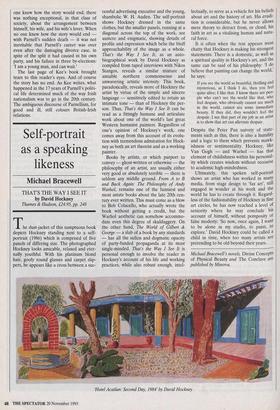Self-portrait as a speaking likeness
Michael Bracewell
THAT'S THE WAY I SEE IT by David Hackney Thames & Hudson, £24.95, pp. 248 The dust-jacket of this sumptuous book depicts Hockney standing next to a self- portrait (1986) which is comprised of five panels of differing size. The photographed Hockney looks amicable, relaxed and eter- nally youthful. With his platinum blond hair, goofy round glasses and carpet slip- pers, he appears like a cross between a suc- cessful advertising executive and the young, shambolic W. H. Auden. The self-portrait shows Hockney dressed in the same clothes, but the smaller panels, running at a diagonal across the top of the work, are austere and enigmatic, showing details of profile and expression which belie the bluff approachability of the image as a whole. That's the Way I See It, as an auto- biographical work by David Hockney as compiled from taped interviews with Nikos Stangos, reveals a similar mixture of amiable northern commonsense and unwavering artistic intensity. This book, paradoxically, reveals more of Hockney the artist by virtue of the simple and sincere language — sensitively edited to retain an intimate tone — than of Hockney the per- son. Thus, That's the Way I See It can be read as a fittingly humane and articulate work about one of the world's last great Western humanist painters. Regardless of one's opinion of Hockney's work, one comes away from this account of its evolu- tion with tremendous admiration for Hock- ney as both an art theorist and as a working painter.
Books by artists, or which purport to convey — ghost-written or otherwise — the philosophy of an artist, are usually, either very good or absolutely terrible — there is seldom any middle ground. From A to B and Back Again: The Philosophy of Andy Warhol, remains one of the funniest and most astute books about the late 20th cen- tury ever written. This must come as a blow to Bob Colacello, who actually wrote the book without getting a credit, but the Warhol aesthetic can somehow accommo- date even this degree of skulduggery. On the other hand, The World of Gilbert & George — a slab of a book by any standards — has all the sullen and dogmatic opacity of party-funded propaganda at its most single-minded. That's the Way I See It is personal enough to involve the reader in Hockney's account of his life and working practices, while also robust enough, intel- lectually, to serve as a vehicle for his beliefs about art and the history of art. His erudi- tion is considerable, but he never allows mere theory to detract from, or cloud, his faith in art as a vitalising human and natu- ral force.
It is often when the text appears most chatty that Hockney is making his strongest statements. There is a domestic, as well as a spiritual quality in Hockney's art, and the same can be said of his philosophy: 'I do believe that painting can change the world,' he says: If you see the world as beautiful, thrilling and mysterious, as I think I do, then you feel quite alive; I like that. I know there are peo- ple who can't see the world like that, who feel despair, who obviously cannot see much in the world, cannot see some immediate beauty. If they did, they wouldn't feel the despair. I see that part of my job as an artist is to show that art can alleviate despair.
Despite the Peter Pan naivety of state- ments such as this, there is also a humility and a logic to them which prevents mawk- ishness or sentimentality. Hockney, like Van Gogh — and Warhol — has that element of childishness within his personal- ity which creates wisdom without recourse to academic high-mindedness. Ultimately, this spoken self-portrait shows an artist who has worked in many media, from stage design to 'fax art', still engaged in wonder at his work and the world he has to create through it. Regard- less of the fashionability of Hockney in fine art circles, he has now reached a level of seniority where he may conclude his account of himself, without pomposity or false modesty: 'So now, once again, I want to be alone in my studio, to paint, to explore.' David Hockney could be called a child in time, when too many artists are pretending to be old beyond their years.
Michael Bracewell's novels, Divine Concepts of Physical Beauty and The Conclave are published by Minerva.
`Hotel Aeatlan: Second Day, 1984' by David Hockney










































































 Previous page
Previous page